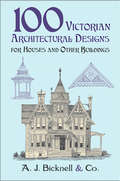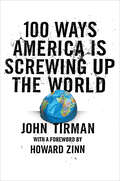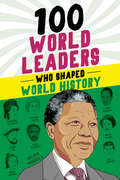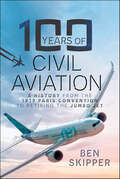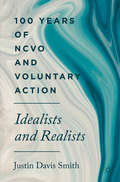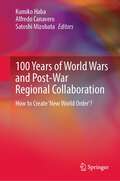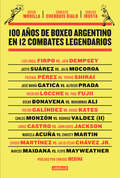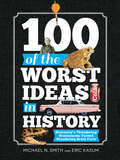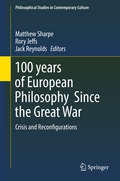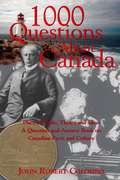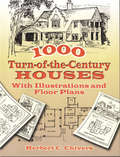- Table View
- List View
100 Turning Points in Military History: The Critical Decisions, Key Events, and Breakthrough Inventions and Discoveries That Shaped Warfare Around the World
by Alan AxelrodThe typical military history presents a chronicle of battles and wars and the commanders and troops who fought them. This book takes a different approach. It presents battles and wars and people aplenty, but they are not its ultimate subjects. This book is about the turning points that not only make military history dynamic but crucial to the story of humanity and civilization. This book is about the decisions, acts, innovations, errors, ideas, successes, and failures that shaped the evolution of military art and science—strategy, tactics, and technology—and, in doing so, shaped the course of world history. Here are the 100 points—from the birth of warfare in the Battle of Megiddo, 1457 BC, to the ongoing evolution of military history on its newest battlefield, cyberspace—at which the path of the warrior decisively turned on its long journey to where we find ourselves today.
100 Victorian Architectural Designs for Houses and Other Buildings (Dover Architecture)
by Co. A. J. BicknellOriginally published in 1878, this now-rare collection of designs supplies views of a remarkable variety of modestly priced structures: houses, villas, cottages, many others. Handsome drawings of perspective views and elevations, some of which include floor plans, plus suggestions for interior design. 98 black-and-white illustrations.
100 Ways America Is Screwing Up the World
by John TirmanWhat do George W. Bush, Wal-Mart, Halliburton, gangsta rap, and SUVs have in common? They're all among the hundred ways in which America is screwing up the world. The country that was responsible for many, if not most, of the twentieth century's most important scientific and technological advancements now demonizes its scientists and thinkers in the twenty-first, while dumbing down its youth with anti-Darwin/pro-"Intelligent Design" propaganda. The longtime paragon of personal freedoms now supports torture and illegal wiretapping—spreading its principles and policies at gunpoint while ruthlessly bombing the world with Big Macs and Mickey Mouse ears.At once serious-minded and satirical, John Tirman's 100 Ways America Is Screwing Up the World is an insightful, unabashed, entertaining, and distressing look at where we've gone terribly wrong—from the destruction of the environment to the promotion of abhorrent personal health and eating habits to the "wussification" of the free press—an alternately admonishing and amusing call to arms for patriotic Blue America.
100 Weirdest Tales from Across Australia
by Ben PobjieTales of the strange, unnerving and downright bizarre from one of the weirdest places on EarthFish falling out of the sky, joggers relieving themselves on your doorstep, mysterious monsters constantly springing from the shadows, spooky lights and ill-conceived toast spreads: these are just some of the things you can expect on any given day in our surreal southern land.In 100 Weirdest Tales from Across Australia, comedy writer and accredited weirdness expert Ben Pobjie delves deep into Australia's past and present to serve up the weirdest stories of all, which will leave you smacking your gob with one hand while scratching your head with the other.
100 Weirdest Tales from Across Australia
by Ben PobjieTales of the strange, unnerving and downright bizarre from one of the weirdest places on EarthFish falling out of the sky, joggers relieving themselves on your doorstep, mysterious monsters constantly springing from the shadows, spooky lights and ill-conceived toast spreads: these are just some of the things you can expect on any given day in our surreal southern land.In 100 Weirdest Tales from Across Australia, comedy writer and accredited weirdness expert Ben Pobjie delves deep into Australia's past and present to serve up the weirdest stories of all, which will leave you smacking your gob with one hand while scratching your head with the other.
100 Women Who Shaped World History
by Gail Meyer RolkaA comprehensive collection of one page synopses of 100 women of major importance in our history. Presents information in chronological order, contains timeline, and a trivia quiz. The book begins in 1503 BC and ends by telling the stories of women who are still making history.
100 Women Who Shaped World History (100 Series)
by Gail Meyer RolkaLearn all about the fascinating lives and tremendous impact of 100 extraordinary women around the world with this fact-filled biography collection for kids. Educational and engaging, 100 Women Who Shaped World History features:Simple, easy-to-read text that has been freshly updatedIllustrated portraits of each figureFascinating facts about famous and lesser-known female figures from historyA timeline, trivia questions, project ideas and more!From Cleopatra to Joan of Arc, Ada Lovelace to Harriet Tubman, Amelia Earhart to Rosa Parks and many more, readers will dive into the lives of 100 female artists, activists, scientists, and icons who left their mark on history. Organized chronologically, this thoroughly researched biography collection offers a look at the contributions these women made and how their talents, discoveries, and ideas have helped guide humanity for thousands of years.
100 World Leaders Who Shaped World History (100 Series)
by Kathy PaparchontisLearn all about the fascinating lives and tremendous impact of 100 influential leaders around the world and throughout history with this fact-filled biography collection for kids 8 and upThis easy-to-read biography collection includes:100 one-page biographies: Find out how these individuals from around the world changed the course of history!Illustrated portraits: Each biography includes an illustration to help bring history to life!A timeline, trivia questions, project ideas, and more: Boost your learning and test your knowledge with fun activities and resources!From Hammurabi to Catherine the Great, Winston Churchill to Nelson Mandela and many more, readers will dive into the lives of 100 kings, dictators, popes, prime ministers, and presidents from all over the world. Organized chronologically, this thoroughly researched biography collection offers a look at how the actions of each leader have affected the course of human history, even hundreds and thousands of years after their reign.
100 Years of Archaeology at the University of Michigan: Essays on the Past, Present, and Future of the Discipline (Anthropological Papers Series #101)
by Raven Garvey Brian A. Stewart Michael L. Galaty Tiffany C. Fryer Robin A. Beck Hannah Hoover John O’Shea Alicia Ventresca-MillerThe University of Michigan has been at the forefront of archaeological research for more than 100 years, since 1922, when the Museum of Anthropology (now the Museum of Anthropological Archaeology) was established on the Ann Arbor campus. The goal of its curators for many decades was to create a research and teaching program that emphasized methodological rigor in the analysis of archaeological materials, attempting to solve grand questions about human behavior through fieldwork, collections, and laboratory work. About fifty years ago, the Museum's emphasis shifted to developing archaeological theory when a new generation of curators with processualist leanings made Ann Arbor a testing ground for the so-called New Archaeology. Now, archaeology stands at a crossroads. Some archaeologists refer to the death of archaeological theory. Others stake out opposed camps of generalists and particularists. At U-M, as at many other universities, the past decade has seen a new commitment to collaborative archaeology, working with descendant communities and acknowledging the discipline's roots in colonialism and extraction. In 2022, to celebrate a century of existence, the University of Michigan Museum of Anthropological Archaeology (UMMAA) hosted an international conference to explore possibilities for a middle way: an archaeology for the next 100 years, combining humanistic and scientific approaches, which allows for both agents and systems, description and explanation, science and heritage. This volume is meant to be a snapshot of that conference and this moment in the development of the discipline. Included are most of the papers and posters presented, as well as photographs of the panels and the proceedings.
100 Years of Baseball on St. Petersburg's Waterfront: How the Game Helped Shape a City (Sports)
by Rick VaughnStep onto the field and bear witness to baseball's outsized impact on Florida's Sunshine City.
100 Years of Civil Aviation: A History from the 1919 Paris Convention to Retiring the Jumbo Jet
by Ben SkipperAn examination of civil aviation history from the end of World War I to the retiring of the Jumbo Jet. The book examines a century of civil aviation; in 1919 a fledgling industry was born out of civilianizing First World War bombers. The book covers the design and development of civil aircraft and all the personalities that shaped the industry; it features the hay-day of air travel before the advent of mass passenger transit, and the rise of smaller, austerity airlines. It covers the influence of military aircraft on civil planes, unpacks the laws that govern civil aviation and how they have changed over the past century. It chronicles air disasters, both mechanical and tyrannical, and for the first time, looks at the role of women in civil aviation. Playing its part in times of crisis, civil aviation has led rescue missions and covert operations; civilian pilots were often used to test and transport new aircraft from their manufacturers to the frontline, often unarmed and unescorted. The book ends with the quiet retirement of an icon, amid a global pandemic and what lies in store for a greener flying future.
100 Years of NCVO and Voluntary Action: Idealists and Realists
by Justin Davis SmithThis book explores the rich history of voluntary action in the United Kingdom over the past 100 years, through the lens of the National Council for Voluntary Organisations (NCVO), which celebrates its centenary in 2019. From its establishment at the end of the First World War, through the creation of the Welfare State in the middle of the twentieth century, to New Labour and the Big Society at the beginning of this century, NCVO has been at the forefront of major developments within society and the voluntary movement. The book examines its many successes, including its role in establishing high-profile charities such as Age Concern, the Youth Hostels Association, and National Association of Citizens’ Advice Bureaux. It charts the development of closer relations with the state, resulting in growing awareness of the value of voluntary action, increased funding, and beneficial changes to public policy, tax and charity law. But it also explores the criticisms NCVO has faced, in particular that by pursuing a partnership agenda and championing professionalisation, it has contributed to an erosion of the movement’s independence and distinctiveness.
100 Years of Planetaria: 100 Stories of People, Places, and Devices (Springer Praxis Books)
by Matthew McMahon Pedro M. P. Raposo Mike Smail Katherine Boyce-JacinoThis book marks the centenary of the remarkable invention of an opto-mechanical planetarium projector, the Zeiss Mk I. In May 1925, the first public planetarium opened at the Deutsches Museum in Munich. In the ensuing decades, this invention spread all over the world, becoming an integral part of modern life. The book presents a global narrative of the modern planetarium and its history through a selection of 100 objects and their stories. Written by a varied international group of contributors including planetarium professionals, scientists, historians, and other experts, these object stories highlight major developments in planetaria as they relate to advances in astronomy and space science as well as changes in society and culture at large. The objects featured in this book show how planetaria gained a central place in modern life at the intersection between science, education, art, and entertainment. They also connect the reader with the diverse people whohave made the modern planetarium a reality and continue to pave the way for its future - be they planetarium staff, scientists, architects, artists, engineers, educators, or planetarium visitors.
100 Years of Women's Suffrage: A University of Illinois Press Anthology
by Dawn Durante100 Years of Women’s Suffrage commemorates the centennial of the Nineteenth Amendment by bringing together essential scholarship on the suffrage movement and women's voting previously published by the University of Illinois Press. With an original introduction by Nancy A. Hewitt, the selections illuminate the lives and work of key figures while uncovering the endeavors of all women—across lines of gender, race, class, religion, and ethnicity—to gain, and use, the vote. Beginning with works that focus on cultural and political suffrage battles, the chapters then look past 1920 to look at how women won, wielded, and continue to fight for access to the ballot. A curation of important scholarship on a pivotal historical moment, 100 Years of Women’s Suffrage captures the complex and enduring struggle for fair and equal voting rights. Contributors: Laura L. Behling, Erin Cassese, Mary Chapman, M. Margaret Conway, Carolyn Daniels, Bonnie Thornton Dill, Ellen Carol DuBois, Julie A. Gallagher, Barbara Green, Nancy A. Hewitt, Leonie Huddy, Kimberly Jensen, Mary-Kate Lizotte, Lady Constance Lytton, and Andrea Radke-Moss
100 Years of World Wars and Post-War Regional Collaboration: How to Create 'New World Order'?
by Kumiko Haba Alfredo Canavero Satoshi MizobataThis book is about the 100 years of World Wars and Regional Collaboration in the twentieth and twenty-first centuries, investigating and considering how to foster Good Governance and New World Order. The world is currently at the historical turning point. The twentieth century witnessed two World Wars (WWI and WWII), followed by the Cold War that dominated geopolitics. Amidst the post-war devastation, the European Community, soon succeeded by the European Union, came into being. Peaceful governance was nurtured by building economic collaboration and institutions and by establishing liberalism, democracy and the rule of law. In Asia, the Association of Southeast Asian Nations (ASEAN) also pursued regional governance after WWII, but in East Asia, the American Divide and Rule policy is continuing until now by the influence of China, North Korea and Russia. In the contemporary world in the twenty-first century, a new nationalism, Populism and Authoritarianism are spreading. At the same time, a wave of rapid economic growth is occurring in developing countries, especially in China and India. Destabilization is spreading in East Asia, Southeast Asia, and South Asia concurrently with the search for “Democratization”. Through the two World Wars and the Cold War which originated in 100 years of the twentieth century, what types of regional institutions and governance have been developed to avoid endless wars and conflicts? In this book, it is examined, what kind of order is necessary to stabilize the regions from conflicts and wars in both Europe and Asia. The themes of the Tokyo Conferences and the Kyoto Conference by SCJ (Science Council of Japan) in December 2020, were investigated and clarified, how the countries that were caught up in global wars have considered regional coexistence in each period, and how to establish peace, stability, and prosperity by means of new institutionalizations, norms and the rule of law. The aim of the authors is to examine and discuss How to create New World Order, Regional Collaborations and Good Governance in the historical power transition period. This book can inspire many scholars and young researchers to join in discussing how to create New World Order in the twenty-first century, from the midst of the unstable situations of the global geopolitics.
100 Years, 100 Moments: A Centennial of NHL Hockey
by Scott MorrisonFor the NHL's 100th season, a fan-friendly, argument starter of a book, compiling the 100 most impactful moments in league history.From ostentatious scoring totals to unstoppable teams destined for championships, the NHL boasts a history of greatness. But as die-hard fans well know, greatness isn't the whole story. In this image-rich, licenced celebration of the NHL's past and present, veteran hockey journalist Scott Morrison mines a century of NHL hockey to find the game's 100 most important moments. From Bobby Orr's 1969-70 trophy haul, to Detroit coach Scotty Bowman's unprecedented icing of five Russians at once on the Red Wings' way to their first of several Stanley Cups, the Stastny brothers' defection, and Roger Neilson reviewing a game on VHS, these moments weren't always the photogenic peaks of athletic glory that graced the morning news, but each of them changed the game.
100 años de boxeo argentino en 12 combates legendarios
by Diego Morilla Carlos Irusta Ernesto Cherquis BialoUn recorrido por la historia del boxeo argentino a través de una selección de peleas insoslayables y de sus figuras más importantes, de la mano de tres de los periodistas que más saben. El 14 de septiembre de 1923, en el Polo Grounds de Nueva York, Luis Firpo y Jack Dempsey se enfrentaron en un combate para el infarto. Firpo regresaría a la argentina con una derrota con gusto a robo para obtener la primera licencia que tuvo el boxeo profesional en el país. Nacía así, cien años atrás, el boxeo argentino. Son muchos los golpes y las figuras que pasaron desde entonces por los cuadriláteros de acá y del mundo. Las doce peleas que se relatan aquí no son las más feroces ni las más taquilleras. Tampoco acaso las "mejores", sino un puñado de las que jalonaron la historia. Todas encierran momentos memorables que duran apenas unos segundos pero dejaron huellas indelebles en el imaginario colectivo. El Torito Suárez llena un estadio para ganarle a Mocoroa. Desde Japón, Pascual Pérez trae el primer campeonato mundial. La rivalidad entre Prada y Gatica trasciende el cuadrilátero para insertarse en la vida política y social de su época. Locche pinta, en su victoria ante Fujii, nuestra primera obra maestra. Ringo Bonavena y Ali protagonizan un verdadero choque de planetas. Y hay más. El uno-dos de Monzón dominando a los medianos de su era. La épica y sangrienta batalla entre Galíndez y Kates. La mano milagrosa del Roña Castro ante Jackson. La hazaña de la Tigresa Acuña desafiando a Christy Martin sin siquiera tener licencia. Maravilla Martínez imponiéndose con talento y drama ante Chávez Jr. El Chino Maidana desafiando al mejor del mundo y poniendo el coraje y los alfajores argentinos en boca de todo el planeta. Cien años de historias escritas en sangre y sudor. Y el relato en las voces de tres generaciones de periodistas que nos traen cada golpe, cada lágrima y cada grito de agonía y de éxtasis de esta gesta que sigue tallando grandes nombres en el deporte argentino.
100 of the Worst Ideas in History
by Michael Smith Eric KasumWhat were they thinking? Ever since Adam snacked on the forbidden fruit and was chased naked out of the Garden of Eden, mankind has bitten off a bevy of bad ideas. From skinny-dipping Presidents to toxic tooth fillings to singing pop stars who can't carry a tune, 100 of the Worst Ideas in History is a celebration of humanity's historical--and often hysterical--missteps that have started wars, sunk countries, wrecked companies, scuttled careers, lost millions, and even endangered the Earth. Discover: How a confused chauffeur helped start World War I Who turned down the greatest product placement opportunity in Hollywood history How a Chicago White Sox game helped hasten the demise of disco The toad that nearly ate Australia The most dangerous children's game ever invented And so much more (of so much less!) Spanning politics, pop culture, fashion, sports, technology, and more, this irreverent and witty book is packed with fun photos and sidebars, tracing how these thundering brainstorms turned into blundering brain farts-and the astonishing impacts our faux pas and foibles still have on us today.
100 years of European Philosophy Since the Great War: Crisis and Reconfigurations (Philosophical Studies in Contemporary Culture #25)
by Matthew Sharpe Jack Reynolds Rory JeffsThis book is a collection of specifically commissioned articles on the key continental European philosophical movements since 1914. It shows how each of these bodies of thought has been shaped by their responses to the horrors set in train by World War I, and considers whether we are yet 'post-post-war'. The outbreak of World War I in August 1914,set in chain a series of crises and re-configurations, which have continued to shape the world for a century: industrialized slaughter, the end of colonialism and European empires, the rise of the USA, economic crises, fascism, Soviet Marxism, the gulags and the Shoah. Nearly all of the major movements in European thinking (phenomenology, psychoanalysis, Hegelianism, Marxism, political theology, critical theory and neoliberalism) were forged in, or shaped by, attempts to come to terms with the global trauma of the World Wars. This is the first book to describe the development of these movements after World War I, and as such promises to be of interest to philosophers and historians of philosophy around the world.
1000 Days on the River Kwai: The Secret Diary of a British Camp Commandant
by Colonel Cary OwtramA British officer recounts his harrowing years as a POW in Thailand, including his time as the camp commandant, in this WWII memoir.Colonel Cary Owtram served with the 137th Field Regiment, Royal Artillery, and the 11th Indian Infantry Division in Malaysia. After being captured by the Japanese in Singapore, he was transported to the infamous Burma railway. He went on to spend the next three and a half years in grueling captivity in Thailand, first in Ban Pong Camp and then Chungkai Camp—one of the largest POW camps in the region. Owtram was appointed the British Camp Commandant at Chungkai, making him responsible for his fellow prisoners—a heavy responsibility added to the general deprivation and hardship suffered by all. During that time, Owtram kept a secret diary in which he recorded the brutal experience of surviving day to day and attempting to deal with their harsh and unpredictable Japanese captors. It is not only the prisoners who suffered, but also their families at home. The postscript by Owtram’s daughters vividly demonstrates the agonies of doubt and worry that loved ones went through and the effect of the experience on all.
1000 Questions About Canada: Places, People, Things and Ideas, A Question-and-Answer Book on Canadian Facts and Culture
by John Robert ColomboWhat are "snow worms"? Are there more moose than people in the Yukon? What is the meaning of the word "Niagara"? Where will you find the world’s largest perogy? Does Elvis have a street in Ottawa named after him? What was Pierre Elliott Trudeau’s favourite snack food? Which province was the last to shift traffic from the left-hand side of the road to the right? These are some of the questions that are asked - and answered - in 1000 Questions About Canada. Every reader with an ounce (or a gram) of curiosity will find these intriguing questions and thoughtful answers fascinating to read and ponder. This book is for people who love curious lore and who want to know more about the country in which they live.
1000 Songs to Change Your Life
by Time Out GuidesLike 1,000 Films and 1,000 Books, 1,000 Songs to Change Your Life, the third book in the series, is a celebration of music's transformative power: how it shocks and soothes, frightens and comforts, amuses and appalls, but above all how it moves us, perhaps when we least expect it. Over the course of more than 30 essays and features, a hand-picked array of writers, critics and musicians will be exploring the songs that made a difference: to their lives, the lives of others and to music itself. Everyone's life has a soundtrack. What's yours?
1000 Turn-of-the-Century Houses: With Illustrations and Floor Plans
by Herbert C. ChiversA remarkable presentation of the "finished ideas of a practicing architect of high rank in his profession," this early-twentieth-century showcase of homes features a wide range of designs from a Midwest master. Reproduced from a rare edition, the work features a splendid array of dwellings, from cottages and bungalows to sprawling mansions. Each house is meticulously illustrated and accompanied by complete floor plans."A poorly planned house is usually more expensive than a modern practical plan," according to the author, architect Herbert C. Chivers. Combining "modern methods" with attractive but modestly priced plans, Chivers promoted his business with sketches of stylish homes, accompanied by brief captions stating dimensions, prices, and occasional suggestions for modifications. This reprint of his complete guide to domestic architecture of the early 1900s constitutes a valuable resource for home hobbyists, architecture students and professionals, as well as antique collectors.
1000 Yard Stare: A Marine's Eye View of the Vietnam War
by Marc Waszkiewicz Lea Jones Crista DoughertyA grunt&’s-eye view of the Vietnam War through hundreds of personal photosMarc Waszkiewicz served three tours (1967, 1968, 1969) as an artillery forward observer with the U.S. Marine Corps in Vietnam, where he took thousands of photos capturing the beauty, drudgery, hilarity, and horror of the war. 1,000-Yard Stare collects the best of these in a book that presents an unvarnished grunt&’s-eye view of the Vietnam War. These are amazing, well-shot photos--most of them color, many of them truly arresting--of Marines in the field, in camp, on base, fighting, patrolling, writing, drinking, carrying on. Some have the feeling of candid snapshots while others are more composed (Waszkiewicz was, and is, an amateur photographer), with subjects ranging from a gunner calculating ranges with pencil and protractor and a chaplain conducting a battlefield mass to grunts smoking illicit substances while pretending to fish and images of barbed wire twisting in the jungle and watchtowers at twilight. Also included are photographs from Waszkiewicz&’s postwar decades of coming to terms with his experiences, such as a sequence of poignant photos from The Wall in Washington and his trip back to Vietnam. This is a visual memoir of the war.
1000 Years for Revenge: International Terrorism and the FBI
by Peter LanceA journalist explores how the FBI overlooked opportunities to stop the 9-11 terrorist attacks. His conclusions are based upon interviews and declassified documents.

